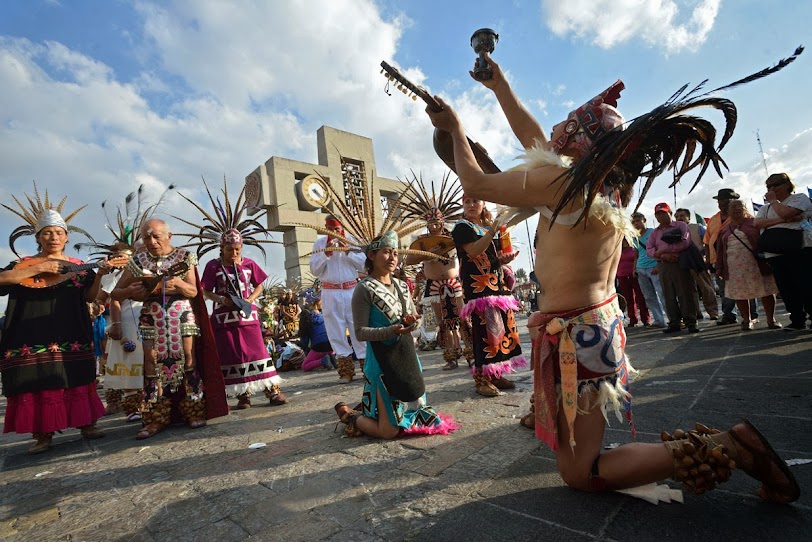Ricardo Valverde's 'Solo Landing'
By Armando Durón
 |
| Boulevard Night, 1970, Gelatin silver print with hand-applied pigment |
I might as well begin with a full disclaimer: I have been a fan of Ricardo Valverde since I first met him in the late 1980s. I have collected his works, and I was honored to speak at his funeral in 1998. So this missive doesn’t come from some alleged objective space where pseudo art critics roam.
A retrospective of Ricardo’s work, which opened at the Vincent Price Gallery at East Los Angeles College on May 17th (and runs through July 26th), under the title Ricardo Valverde: Experimental Sights, 1971-1996, is the first solo exhibition since 1994. But this is his first retrospective and it is well-worth seeing. Featuring a twenty-five year career, with over one hundred works, guest curator Cecilia Fajardo-Hill presents an artist on a mission to distinguish himself even as he might have struggled to seem to stay within the bounds of Chicano artspeak of the times.
This exhibition is a long time in coming, and comes on the heals of the UCLA Chicano Studies Resource Center’s A Ver publication, Ricardo Valverde by Ramón García last year and his inclusion in an exhibition now in Marseille, France entitled, ASCO & Friends: Exiled Portraits. Freed from interpretations and misinterpretations, the viewer will find his or her own way through these galleries and wonder why Valverde isn’t better known, why has he been so ignored.
Part of the answer may be found in the penchant Chicanos and non-Chicanos have for pigeon-holing Chicano artists. It is a state of affairs that is increasingly insupportable as evidence mounts that Chicano art has never been of only one type: colorful, figurative, iconic and political. Valverde’s work as presented here is proof of why that tired paradigm doesn’t work and why every attempt to impose it only results in Chicano art being relegated to a second-tier existence. That mistake isn’t made here.
The exhibition opens with his Master’s Thesis work, “”la juventud y la vejez,” a group of snapshots of young people and elders. Yet even here, where he is at his most documentary, Valverde seizes on images that work to accentuate the aesthetic over the documentary. Notice the old woman and the piñata in one of the frames. The image is arresting as the woman is juxtaposed with the very symbol of youth in Mexican culture; beginning the conversation in a direction that veers away from simple documentation.
And so it goes as the exhibition moves thematically to “Self Portraits,” “The Family” and “Espie,” “Experimentality,” “Mexico/Los Angeles” and “Low Riders in Los Angeles (Urban Scenes).” Images created in 1974 are reworked—almost repurposed—years later. The exhibition points this out time and again almost as if to make something abundantly clear that had not been clear in the monograph of Valverde’s work. That something, I submit, is that Valverde was a unique artist who shunned the confining premise of Chicano documentary photography.
In Untitled (Half Nude), 1979, the bottom half a woman’s body is presented, while in the 1993 version, La Espera II, the same image has been scratched and painted. Meanwhile in Integrated School, Valverde has signed the very same photograph once in 1974 and again in 1994 after reworking the image. What is questioned here is the very definition of Chicano art. Is it a documentation of a community, is it an artist’s reworking of that community, or can it be both without one side accusing the other of being a fallen angel.
The best works are on the other side of a wall that breaks up the space. Look for El Ladrón del Pan Santificado (The Thief of the Holy Bread) 1992, a gelatin silver print with acrylic and gouache, and El Fin de Mundo (The End of the World), 1992, a solarized gelatin silver print with acrylic and gouache. These works represent the apex of Valverde’s career. These aren’t experimental doodles, studies or sketches. These are mature works that synthesize a career of reworking the obvious to suit a sensitive man’s aesthetic.
Experience Boulevard Night (1979), an iconic image, included in the CARA exhibition in 1990. That work is not so much about the Whittier Boulevard cruising scene as it is about the vibe one was left with. It allows the viewer to experience the luminosity of those hot East L.A. nights, the allure of the street, the super charge of the ladies. The piece is more about the reasons for cruising that about the event itself.
Perhaps, Valverde inadvertently added to the notion that his work is documentary: “I think my work is evidence that we Latinos, as all other people of color, are in a struggle to be seen, to be recognized as a vital element of force [sic] in our society”, he was quoted as saying in one catalog. But a closer reading may reveal that he didn’t mean that he wanted to do it via the documentation of the community as much as to be recognized as a legitimate artist by society at large.
Valverde taught me the importance of photography, the why and how of it. “It’s art,” he said “just like painting and drawing. You just have to get over the idea that art is only painting and drawing.” That seems simple now, but in the late eighties it was new to me. Perhaps that is the reason why so many are still having trouble with looking at Chicano art through a wider lens. This exhibition will help the casual viewer and the scholar alike to contemplate the possibility that perhaps another point of departure existed all along.
[Other events associated with the exhibition include, a conversation with the Cecilia Fajardo-Hill, Ramón García, Chon Noriega and Rubén Ortiz Torres on June 14th from 2:00 to 4:00 p.m., and a Walk through with the curator Cecilia Fajardo-Hill on June 21st at 2:00 p.m.]




Comments
Post a Comment